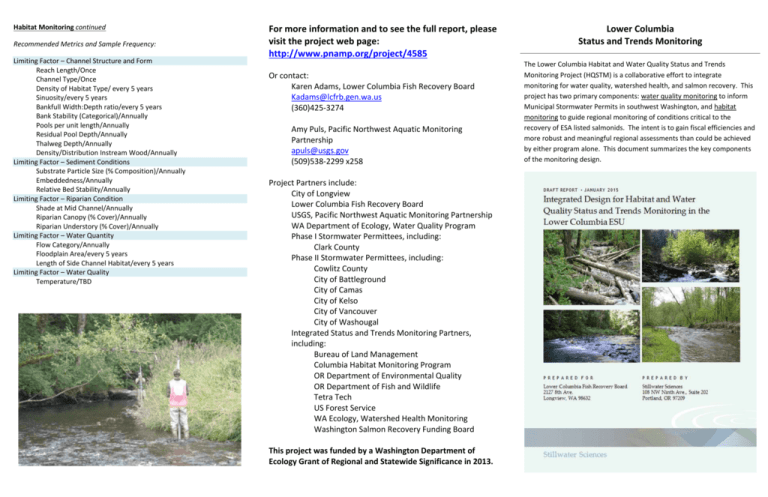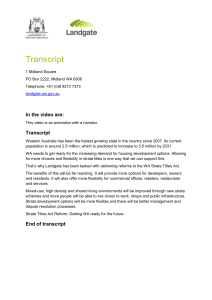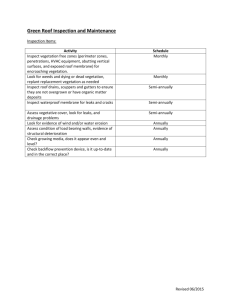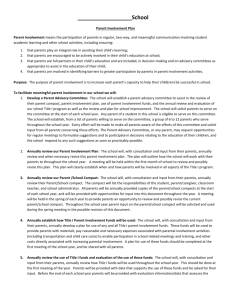hstm_workshop_4_trifold_monitoring_design_handout_final
advertisement

Habitat Monitoring continued Recommended Metrics and Sample Frequency: Limiting Factor – Channel Structure and Form Reach Length/Once Channel Type/Once Density of Habitat Type/ every 5 years Sinuosity/every 5 years Bankfull Width:Depth ratio/every 5 years Bank Stability (Categorical)/Annually Pools per unit length/Annually Residual Pool Depth/Annually Thalweg Depth/Annually Density/Distribution Instream Wood/Annually Limiting Factor – Sediment Conditions Substrate Particle Size (% Composition)/Annually Embeddedness/Annually Relative Bed Stability/Annually Limiting Factor – Riparian Condition Shade at Mid Channel/Annually Riparian Canopy (% Cover)/Annually Riparian Understory (% Cover)/Annually Limiting Factor – Water Quantity Flow Category/Annually Floodplain Area/every 5 years Length of Side Channel Habitat/every 5 years Limiting Factor – Water Quality Temperature/TBD For more information and to see the full report, please visit the project web page: http://www.pnamp.org/project/4585 Or contact: Karen Adams, Lower Columbia Fish Recovery Board Kadams@lcfrb.gen.wa.us (360)425-3274 Amy Puls, Pacific Northwest Aquatic Monitoring Partnership apuls@usgs.gov (509)538-2299 x258 Project Partners include: City of Longview Lower Columbia Fish Recovery Board USGS, Pacific Northwest Aquatic Monitoring Partnership WA Department of Ecology, Water Quality Program Phase I Stormwater Permittees, including: Clark County Phase II Stormwater Permittees, including: Cowlitz County City of Battleground City of Camas City of Kelso City of Vancouver City of Washougal Integrated Status and Trends Monitoring Partners, including: Bureau of Land Management Columbia Habitat Monitoring Program OR Department of Environmental Quality OR Department of Fish and Wildlife Tetra Tech US Forest Service WA Ecology, Watershed Health Monitoring Washington Salmon Recovery Funding Board This project was funded by a Washington Department of Ecology Grant of Regional and Statewide Significance in 2013. Lower Columbia Status and Trends Monitoring The Lower Columbia Habitat and Water Quality Status and Trends Monitoring Project (HQSTM) is a collaborative effort to integrate monitoring for water quality, watershed health, and salmon recovery. This project has two primary components: water quality monitoring to inform Municipal Stormwater Permits in southwest Washington, and habitat monitoring to guide regional monitoring of conditions critical to the recovery of ESA listed salmonids. The intent is to gain fiscal efficiencies and more robust and meaningful regional assessments than could be achieved by either program alone. This document summarizes the key components of the monitoring design. Water Quality Monitoring Strata: Stratification of sites allows us to compare data among like sites to strengthen our ability to characterize conditions and detect trends over time. Recommended strata for water quality monitoring include: Inside/outside NPDES Urban Areas Drainage area Predominant Land Cover of the watershed Number of Primary Populations in subbasin Water Quality Monitoring continued Outside the NPDES Urban Areas (referred to as “regional water quality monitoring”) there are 3 relevant strata, each with 3 combinations x 15 sites each = 135 sites o Drainage Area: 3 categories (0.6-2.5, 2.6-50, 50-200 km2) o Predominant Land Cover: 3 categories (forested, agricultural, and urban) o Number of Primary Salmonid Populations in subbasin: 3 categories (0-2, 3, 4+) Habitat Monitoring Strata: Recommended strata for habitat monitoring include: Inside/outside NPDES Urban Areas Drainage Area Stream Gradient Predominant Land Cover Number of Primary Salmonid Populations in subbasin Number of Sites Sampled: The recommended number of sites sampled for each strata combination is variable in habitat monitoring practice and literature. There is no precedent set at this time; therefore, a target of 15 sites/ strata combination was adopted for consistency with the water quality monitoring design. There are 360 total strata combinations but only 84 meet the 15sample criteria x 15 sites each = 1,260 sites. Number of Sites Sampled: The recommended number of sites sampled for each strata combination is a minimum of 15, based on precedence set in practice and documented in the stormwater literature. Locations should be identified by reach. Inside NPDES Urban Areas there is only one relevant combination of strata – 15 reaches needed o Drainage area: 1 category (2.6-50 km2) o “Urban” land cover: 1 category Recommended Metrics and Sample Frequency: Water Temperature/Continuous (e.g., hourly) Sediment Metals/Annually Conductivity/Continuously Stream Stage/Continuously Macroinvertebrate Index/Annually Bankfull Width & Depth/ One time per permit period (5 years) Wetted Width/Each site visit Substrate Size/ One time Recommended for future consideration, based on upcoming experience by others: Chloride/Monthly Total Nitrogen/Monthly Sediment Polyaromatic Hydrocarbons (PAHs)/Annually Periphyton/Annually Inside/outside NPDES Urban Areas = 2 categories Drainage Area: 5 categories (0.6-2.5, 2.5-50, 50-200, 200-1000, >1000 km2) Stream Gradient: 4 categories (<1.5%, 1.5-3%, 3-7.5%, >7.5%) Predominant Land Cover: 3 categories (Forested, Agricultural, Urban) Number of Primary Salmonid Populations in subbasin: 3 categories (0-2, 3, 4+)




